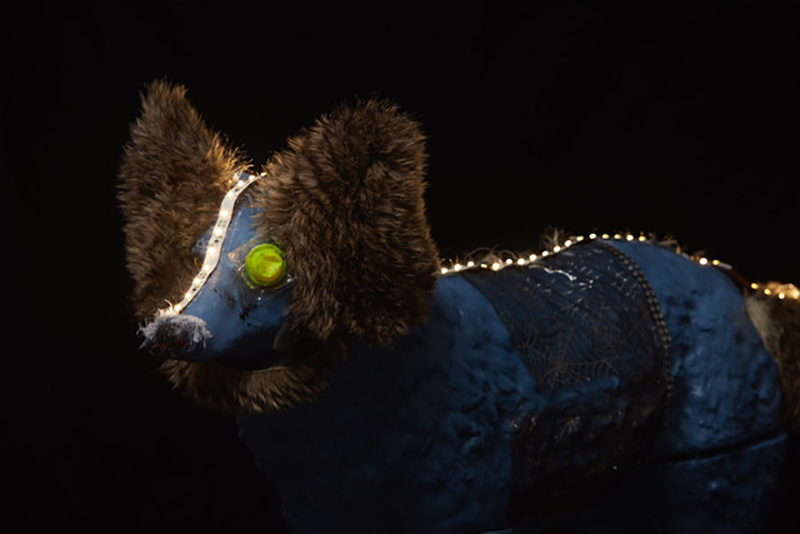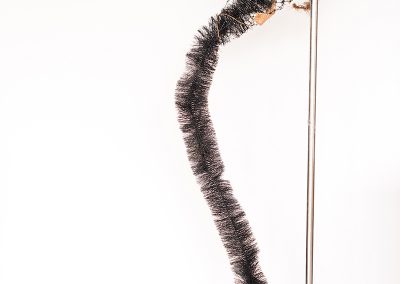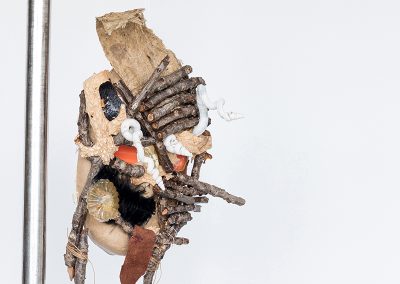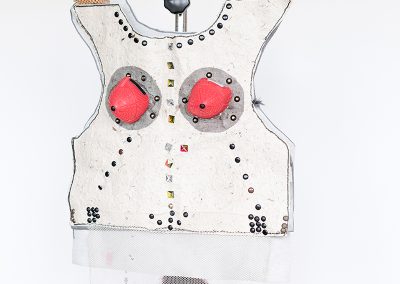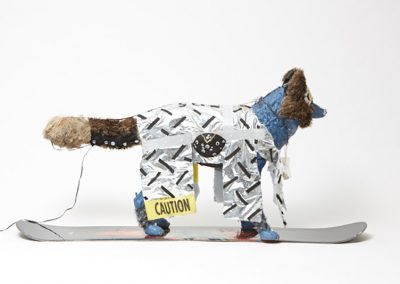Wolf Dog
Fully domesticated dogs can take part in hunting, act as guard animals, and be used as for the transport of people and baggage. It has been suggested by one scholar that ‘wolf-dogs’, along with better weapons and skill in hunting, gave early modern humans a competitive advantage and thus contributed to the disappearance of Neanderthals. CONTESTED. Our wolf-dog is shown with some wolf-like and other more doggish features, including yellow eyes (w) and a tail which can curl slightly at the tip (d). She is also equipped with an Ice Age survival kit: snow goggles, a snowboard, anti-ice armour, food bones, and a breathing tube for use in case of burial by avalanche. 2018-19, Mixed Media. Photograph: David Ellington
Skull
The conscious collecting, admiration or contemplation of objects is a cultural activity of probable great antiquity. This contemporary interpretation of a ‘ritual’ object is based on a Cervidae skull and antlers, to which have been attached natural history specimens and objects in materials such as plastic and metal, neither of which were available to Neanderthals. Such animals were a food source for some Neanderthal groups. 2018-19, Mixed Media. Photograph: David Elllington
Dance Rink
Neanderthals shaped as many as 400 stalagmites into two oval structures deep inside a French cave some 176,000 years ago. Scientists are unsure what use these walled constructions since being reported in 2016, probably lit with fires, were put. Ours is a dance rink, which is one of the possibilities. CONTESTED. Some researchers have argued that caves occupied by Neanderthals reveal organized areas for sleeping, making of tools, food preparation, butchering, working bone and antler, which implies the ability to conceptualise space. CONTESTED. If true, as suggested by a site in Jordan, they also had complex social organization and behavior more like early modern humans. Jeanne Cannizzo and Kerry Samantha Boyes (fabricator). Photograph: Alicia Bruce
Infant Burial
Archaeological evidence suggests that Neanderthals took care of their sick, old or dependent members. Burial practices seem to have included covering or nestling bodies among rocks in the back of caves. CONTESTED At a Neanderthal site in Iraq wildflowers may have been left on a ‘grave’ although most archaeologists suggest that the pollen just blew into the cave or may have been from gerbil nests. REPUDIATED. The body in our imagined miniature burial site has been painted. Mineral pigments, for example yellow and red ochre, and black were available to Neanderthals for bodily adornment and the decoration of objects. 2019, mixed media. Photograph: Alicia Bruce
De-extinction by cloning
The mammoth DNA genome (a ‘blueprint’ for making a species) has been almost fully identified and in theory it would be possible to clone one. ‘De-extinction’ is possible. So far no one has yet done this, although cloning from non-extinct species has been achieved, most famously with Dolly the Sheep in Scotland in 1996. 2019, mixed media. Photograph; Alicia Bruce
Squashed Baby Mammoth Head
Over hundreds of thousands of years, woolly mammoths ranged the grasslands from Scotland to the Yukon. A small group may have survived until 4,000 years ago on an island off Siberia. Compared to an elephant, the mammoth has a shaggy coat, small round ears, and curved tusks. This sculpture was inspired by a mummified mammoth some 39,000 years old which was found in 2010 in Russia. Yuka, as the juvenile female was nick-named, had been preserved under permafrost which flattened the body. Some of the internal organs had been removed by humans although which kind is unclear. 2019. Photograph: Alicia Bruce
Hunting Mask
Most organic materials such as wood, vegetable fibres, hides and fur or hair do not survive in the archaeological record, so it is unknown if Neanderthals made masks. It is clear, according to scientific analysis of anatomy and artefacts, that they had some sort of language and were thus capable of symbolic or abstract thought, and interested in ritual. CONTESTED. This mask is meant to ‘confuse’ potential game while offering ritual protection to the Neanderthal hunter. 2019, mixed media. Photograph: Alicia Bruce
Whale vertebrae bracelet with engraved and coloured markings
Personal adornment indicates a certain degree not only of consciousness of the self, but also individuality. The design on this bracelet, made for this exhibition, references an abstract crosshatching found in the bedrock of a cave in Gibraltar. It was engraved with a pointed stone tool by a Neanderthal. CONTESTED. Hand stencils made by blowing red ochre from the mouth to make an outline of the hand is a not uncommon feature of European cave art, and always assumed to have been made by early modern humans. However, new dating from a Spanish cave has shown that at least one of them were made by a Neanderthal before early modern humans arrived. CONTESTED. 2019, mixed media. Photograph: Alicia Bruce
Staff
It has been known since 2012 that some Neanderthals, using stone tools, removed the dark wing feathers and talons of corvids and raptors for ritual purposes or adorning themselves. CONTESTED This is symbolic behaviour and an expression of advanced cognitive abilities. No such Neanderthal object such as the one here has been found. 2019, mixed media. Photograph: Alicia Bruce
Spare Parts (cloned)
Some scientists believe that, eventually, a Neanderthal might be ‘de-extincted’. In either case, this would raise important ethical issues, as the clone would, at least initially, be without others like itself. Both mammoths and humans are social beings, needing each other to survive. Nor would the clone have the original physical environment to which its species was habituated. For the ‘hosting’ group into which the clone was introduced there might be unexpected dangers. Some scientists have speculated that such clones might be ‘ecologically disruptive’ or carry past diseases into new populations. 2019, mixed media. Photograph: Alicia Bruce
Anti-stab vest for female mammoth hunter
Neanderthals used a thrusting spear to kill large animals. A stone tip was attached to a wooden shaft with pitch made by burning birch tree bark. This technique required close contact with their prey. Fossil finds suggest Neanderthal hunters were sometimes wounded by mammoth tusks. Although they may have had different roles, both men and women took part in hunting. Neanderthal teeth reveal that some groups ate more wild plants, fruits and berries than at first supposed. There is no suggestion that women did only gathering and men only hunting. 2019, mixed media. Photograph: Alicia Bruce

